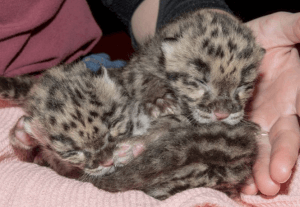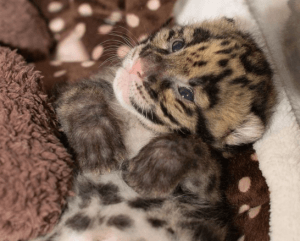Two very cute cubs were born to Lowry Park Zoo’s (Tampa, Florida) clouded leopard couple, Malee and Yim, on 29 February. However, Malee stopped feeding her cubs after the first day so zoo staff have stepped up to the task.
The cubs are a male and female and the zoo says they are “stable.” They are receiving 24 hour care in the zoo’s veterinary hospital, including four-hourly bottle feeding.
According to ZooBorns:
Though parent-rearing is often best for zoo-dwelling animals, Clouded Leopards are routinely hand-reared for increased chances of survival. Hand-rearing also improves socialization for early introductions to potential mates and reduces fatal attacks by aggressive adults. …
Clouded Leopards are the smallest of the “big cats,” weighing 30-50 pounds in adulthood and measuring about five feet long nose to tail. Native to Southeast Asia, Clouded Leopards are found in forests and rain forests. Shy and reclusive, these forest-dependent cats’ wild homes are being deforested faster than any other regions in the world.
Trigger-warning for cuteness! One of the cubs being fed:
There are only about 10,000 clouded leopards (Neofelis nebulosa) left in the world. They are classified as Vulnerable by the International Union of Conservation of Nature (IUCN). As well as the deforestation leading to habitat destruction mentioned above, clouded leopards are also being hunted and thus their numbers are declining.
The clouded leopard is (apparently – I don’t know about these things) considered the evolutionary link between big cats and small cats though despite its name, it’s not related to leopards.
Malee and Yim had their first cub (above right) this time last year when they were both four years old. They had been paired at six months, hoping they would breed. That kitten was hand-reared by zoo staff, which may be why Malee didn’t successfully care for her cubs this time. The zoo explained at the time to ZooBorns:
The Zoo’s veterinary team is providing round-the-clock care for the kitten under the protocol established by the Association of Zoos and Aquariums (AZA), Clouded Leopard Species Survival Plan (SSP).
The new cubs’ big brother was just as cute as they are at the same age:
https://youtu.be/_en2pFPyV1s
It’s disappointing that deforestation is a threat to clouded animals, but that’s not the only danger to these gorgeous animals. These are the threats to them according to Wikipedia:
Many of the remaining forest areas are too small to ensure the long-term persistence of clouded leopard populations. They are threatened by habitat loss following large–scale deforestation and commercial poaching for the wildlife trade. Skins, claws, and teeth are offered for decoration and clothing, bones and meat as substitute for tiger in traditional Asian medicines and tonics, and live animals for the pet trade. Few poaching incidents have been documented, but all range states are believed to have some degree of commercial poaching. In recent years, substantial domestic markets existed in Indonesia, Myanmar, and Vietnam.
In Myanmar, 301 body parts of at least 279 clouded leopards, mostly skins and skeletons, were observed in four markets surveyed between 1991 and 2006. Three of the surveyed markets are situated on international borders with China and Thailand, and cater to international buyers, although clouded leopards are completely protected under Myanmar’s national legislation. Effective implementation and enforcement of CITES is considered inadequate.
As is so often the case, one of the major threats to endangered species is the perpetration of the unproven and ignorant folk medicine/tonic trade. In the 21st century, we know these things don’t work and it’s time governments did more than just pass a law making them illegal to satisfy their conditions of membership of the United Nations.



Squeeee!
😀
Excellent post. I was particularly impressed by that final paragraph. I have ‘pressed’ this on to aspiblog.wordpress.com
Cheers Thomas. Very cool. 🙂
It is a beautiful thing for sure… I find it heartening to see us humans doing this kind of work. Of course, it seems to be always offset by horrible and unnecessary poaching rubbish!